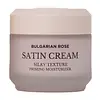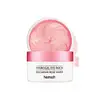What's inside
What's inside
 Key Ingredients
Key Ingredients

 Benefits
Benefits

 Concerns
Concerns

 Ingredients Side-by-side
Ingredients Side-by-side

Water
Skin ConditioningGlycerin
HumectantPropanediol
SolventCaprylic/Capric Triglyceride
MaskingCetyl Ethylhexanoate
EmollientDimethicone
EmollientNiacinamide
SmoothingCyclopentasiloxane
EmollientButyrospermum Parkii Butter
Skin ConditioningPalmitic Acid
EmollientPolysorbate 60
EmulsifyingStearic Acid
CleansingSodium Polyacryloyldimethyl Taurate
Emulsion StabilisingSodium Acrylate/Sodium Acryloyldimethyl Taurate Copolymer
Emulsion StabilisingIsohexadecane
EmollientCI 77891
Cosmetic ColorantHydrogenated Polydecene
EmollientDimethiconol
EmollientSorbitan Stearate
EmulsifyingCaprylyl Glycol
EmollientChlorphenesin
AntimicrobialSodium Polyacrylate Starch
AbsorbentRosa Damascena Flower Water
MaskingPhenoxyethanol
PreservativePolysorbate 80
EmulsifyingDimethicone/Vinyl Dimethicone Crosspolymer
Skin ConditioningEthylhexylglycerin
Skin ConditioningButylene Glycol
HumectantSorbitan Oleate
EmulsifyingCitrus Aurantium Dulcis Peel Oil
MaskingTrideceth-10
CleansingAdenosine
Skin ConditioningPelargonium Graveolens Flower Oil
MaskingDisodium EDTA
Parfum
MaskingAluminum Hydroxide
EmollientMica
Cosmetic ColorantTriethoxycaprylylsilane
CI 77491
Cosmetic Colorant1,2-Hexanediol
Skin ConditioningCamellia Sinensis Leaf Extract
AntimicrobialSilica
AbrasiveCastanea Crenata Shell Extract
Skin ConditioningLavandula Angustifolia Flower Extract
CleansingVaccinium Macrocarpon Fruit Extract
AstringentTin Oxide
AbrasiveLactobionic Acid
BufferingPropylene Glycol
HumectantCrataegus Monogyna Flower Extract
Skin ConditioningHibiscus Sabdariffa Flower Extract
Skin ConditioningViola Tricolor Extract
EmollientAscorbic Acid
AntioxidantCitric Acid
BufferingMalic Acid
BufferingTartaric Acid
BufferingLimonene
PerfumingCitronellol
PerfumingGeraniol
PerfumingLinalool
PerfumingCitral
PerfumingWater, Glycerin, Propanediol, Caprylic/Capric Triglyceride, Cetyl Ethylhexanoate, Dimethicone, Niacinamide, Cyclopentasiloxane, Butyrospermum Parkii Butter, Palmitic Acid, Polysorbate 60, Stearic Acid, Sodium Polyacryloyldimethyl Taurate, Sodium Acrylate/Sodium Acryloyldimethyl Taurate Copolymer, Isohexadecane, CI 77891, Hydrogenated Polydecene, Dimethiconol, Sorbitan Stearate, Caprylyl Glycol, Chlorphenesin, Sodium Polyacrylate Starch, Rosa Damascena Flower Water, Phenoxyethanol, Polysorbate 80, Dimethicone/Vinyl Dimethicone Crosspolymer, Ethylhexylglycerin, Butylene Glycol, Sorbitan Oleate, Citrus Aurantium Dulcis Peel Oil, Trideceth-10, Adenosine, Pelargonium Graveolens Flower Oil, Disodium EDTA, Parfum, Aluminum Hydroxide, Mica, Triethoxycaprylylsilane, CI 77491, 1,2-Hexanediol, Camellia Sinensis Leaf Extract, Silica, Castanea Crenata Shell Extract, Lavandula Angustifolia Flower Extract, Vaccinium Macrocarpon Fruit Extract, Tin Oxide, Lactobionic Acid, Propylene Glycol, Crataegus Monogyna Flower Extract, Hibiscus Sabdariffa Flower Extract, Viola Tricolor Extract, Ascorbic Acid, Citric Acid, Malic Acid, Tartaric Acid, Limonene, Citronellol, Geraniol, Linalool, Citral
Water
Skin ConditioningGlycerin
HumectantNiacinamide
SmoothingChondrus Crispus
MaskingButylene Glycol
HumectantCocos Nucifera Fruit Extract
EmollientPinus Sylvestris Leaf Extract
TonicPropanediol
SolventPentylene Glycol
Skin ConditioningRosa Damascena Flower Water
MaskingNelumbo Nucifera Flower Extract
Skin ConditioningPortulaca Oleracea Extract
Skin ConditioningHamamelis Virginiana Extract
AntiseborrhoeicCentella Asiatica Extract
CleansingEthylhexylglycerin
Skin ConditioningSodium Hyaluronate
HumectantDipotassium Glycyrrhizate
HumectantPEG-60 Hydrogenated Castor Oil
EmulsifyingCeratonia Siliqua Gum
EmollientSucrose
HumectantPotassium Chloride
Cyamopsis Tetragonoloba Gum
Emulsion StabilisingCalcium Chloride
AstringentAllantoin
Skin ConditioningTripropylene Glycol
AntioxidantDipropylene Glycol
HumectantCellulose Gum
Emulsion StabilisingChondrus Crispus Powder
AbrasiveRicinus Communis Seed Oil
MaskingCalcium Aluminum Borosilicate
Tin Oxide
AbrasiveCI 75470
Cosmetic ColorantCalcium Lactate
AstringentAdenosine
Skin ConditioningSynthetic Fluorphlogopite
Titanium Dioxide
Cosmetic ColorantDisodium EDTA
Ethyl Hexanediol
Solvent1,2-Hexanediol
Skin ConditioningChlorphenesin
AntimicrobialArginine
MaskingParfum
MaskingWater, Glycerin, Niacinamide, Chondrus Crispus, Butylene Glycol, Cocos Nucifera Fruit Extract, Pinus Sylvestris Leaf Extract, Propanediol, Pentylene Glycol, Rosa Damascena Flower Water, Nelumbo Nucifera Flower Extract, Portulaca Oleracea Extract, Hamamelis Virginiana Extract, Centella Asiatica Extract, Ethylhexylglycerin, Sodium Hyaluronate, Dipotassium Glycyrrhizate, PEG-60 Hydrogenated Castor Oil, Ceratonia Siliqua Gum, Sucrose, Potassium Chloride, Cyamopsis Tetragonoloba Gum, Calcium Chloride, Allantoin, Tripropylene Glycol, Dipropylene Glycol, Cellulose Gum, Chondrus Crispus Powder, Ricinus Communis Seed Oil, Calcium Aluminum Borosilicate, Tin Oxide, CI 75470, Calcium Lactate, Adenosine, Synthetic Fluorphlogopite, Titanium Dioxide, Disodium EDTA, Ethyl Hexanediol, 1,2-Hexanediol, Chlorphenesin, Arginine, Parfum
 Reviews
Reviews

Ingredients Explained
These ingredients are found in both products.
Ingredients higher up in an ingredient list are typically present in a larger amount.
1,2-Hexanediol is a synthetic liquid and another multi-functional powerhouse.
It is a:
- Humectant, drawing moisture into the skin
- Emollient, helping to soften skin
- Solvent, dispersing and stabilizing formulas
- Preservative booster, enhancing the antimicrobial activity of other preservatives
Adenosine is in every living organism. It is one of four components in nucleic acids that helps store our DNA.
Adenosine has many benefits when used. These benefits include hydrating the skin, smoothing skin, and reducing wrinkles. Once applied, adenosine increases collagen production. It also helps with improving firmness and tissue repair.
Studies have found adenosine may also help with wound healing.
In skincare products, Adenosine is usually derived from yeast.
Learn more about AdenosineButylene Glycol (or BG) is used within cosmetic products for a few different reasons:
Overall, Butylene Glycol is a safe and well-rounded ingredient that works well with other ingredients.
Though this ingredient works well with most skin types, some people with sensitive skin may experience a reaction such as allergic rashes, closed comedones, or itchiness.
Learn more about Butylene GlycolChlorphenesin is a synthetic preservative. It helps protect a product against bacteria in order to extend shelf life. In most cases, Chlorphenesin is paired with other preservatives such as phenoxyethanol and caprylyl glycol.
Chlorphenesin is a biocide. This means it is able to help fight the microorganisms on our skin. It is also able to fight odor-releasing bacteria.
Chlorphenesin is soluble in both water and glycerin.
Studies show Chlorphenesin is easily absorbed by our skin. You should speak with a skincare professional if you have concerns about using Chlorphenesin.
Learn more about ChlorphenesinDisodium EDTA plays a role in making products more stable by aiding other preservatives.
It is a chelating agent, meaning it neutralizes metal ions that may be found in a product.
Disodium EDTA is a salt of edetic acid and is found to be safe in cosmetic ingredients.
Learn more about Disodium EDTAEthylhexylglycerin (we can't pronounce this either) is commonly used as a preservative and skin softener. It is derived from glyceryl.
You might see Ethylhexylglycerin often paired with other preservatives such as phenoxyethanol. Ethylhexylglycerin has been found to increase the effectiveness of these other preservatives.
Glycerin is already naturally found in your skin. It helps moisturize and protect your skin.
A study from 2016 found glycerin to be more effective as a humectant than AHAs and hyaluronic acid.
As a humectant, it helps the skin stay hydrated by pulling moisture to your skin. The low molecular weight of glycerin allows it to pull moisture into the deeper layers of your skin.
Hydrated skin improves your skin barrier; Your skin barrier helps protect against irritants and bacteria.
Glycerin has also been found to have antimicrobial and antiviral properties. Due to these properties, glycerin is often used in wound and burn treatments.
In cosmetics, glycerin is usually derived from plants such as soybean or palm. However, it can also be sourced from animals, such as tallow or animal fat.
This ingredient is organic, colorless, odorless, and non-toxic.
Glycerin is the name for this ingredient in American English. British English uses Glycerol/Glycerine.
Learn more about GlycerinNiacinamide is a multitasking form of vitamin B3 that strengthens the skin barrier, reduces pores and dark spots, regulates oil, and improves signs of aging.
And the best part? It's gentle and well-tolerated by most skin types, including sensitive and reactive skin.
You might have heard of "niacin flush", or the reddening of skin that causes itchiness. Niacinamide has not been found to cause this.
In very rare cases, some individuals may not be able to tolerate niacinamide at all or experience an allergic reaction to it.
If you are experiencing flaking, irritation, and dryness with this ingredient, be sure to double check all your products as this ingredient can be found in all categories of skincare.
When incorporating niacinamide into your routine, look out for concentration amounts. Typically, 5% niacinamide provides benefits such as fading dark spots. However, if you have sensitive skin, it is better to begin with a smaller concentration.
When you apply niacinamide to your skin, your body converts it into nicotinamide adenine dinucleotide (NAD). NAD is an essential coenzyme that is already found in your cells as "fuel" and powers countless biological processes.
In your skin, NAD helps repair cell damage, produce new healthy cells, support collagen production, strengthen the skin barrier, and fight environmental stressors (like UV and pollution).
Our natural NAD levels start to decline with age, leading to slower skin repair, visible aging, and a weaker skin barrier. By providing your skin niacinamide, you're recharging your skin's NAD levels. This leads to stronger, healthier, and younger looking skin.
Another name for vitamin B3 is nicotinamide. This vitamin is water-soluble and our bodies don't store it. We obtain Vitamin B3 from either food or skincare. Meat, fish, wheat, yeast, and leafy greens contain vitamin B3.
The type of niacinamide used in skincare is synthetically created.
Learn more about NiacinamideParfum is a catch-all term for an ingredient or more that is used to give a scent to products.
Also called "fragrance", this ingredient can be a blend of hundreds of chemicals or plant oils. This means every product with "fragrance" or "parfum" in the ingredients list is a different mixture.
For instance, Habanolide is a proprietary trade name for a specific aroma chemical. When used as a fragrance ingredient in cosmetics, most aroma chemicals fall under the broad labeling category of “FRAGRANCE” or “PARFUM” according to EU and US regulations.
The term 'parfum' or 'fragrance' is not regulated in many countries. In many cases, it is up to the brand to define this term.
For instance, many brands choose to label themselves as "fragrance-free" because they are not using synthetic fragrances. However, their products may still contain ingredients such as essential oils that are considered a fragrance by INCI standards.
One example is Calendula flower extract. Calendula is an essential oil that still imparts a scent or 'fragrance'.
Depending on the blend, the ingredients in the mixture can cause allergies and sensitivities on the skin. Some ingredients that are known EU allergens include linalool and citronellol.
Parfum can also be used to mask or cover an unpleasant scent.
The bottom line is: not all fragrances/parfum/ingredients are created equally. If you are worried about fragrances, we recommend taking a closer look at an ingredient. And of course, we always recommend speaking with a professional.
Learn more about ParfumPropanediol is an all-star ingredient. It softens, hydrates, and smooths the skin.
It’s often used to:
Propanediol is not likely to cause sensitivity and considered safe to use. It is derived from corn or petroleum with a clear color and no scent.
Learn more about PropanediolRosa Damascena Flower Water comes from the Damask rose. It is a dilluted version of the Rose Essential oil.
The Damask Roses' petals have antioxidant, antimicrobial, and fragrance compounds. Though antioxidants are great for soothing skin, the fragrance compounds can irritate it.
Tin Oxide is an inorganic oxide used to add opacity and volume to a product. In nature, it is already found in mineral form. The main ore of tin is an opaque and shiny mineral called casseterite.
Tin Oxide helps remove translucency in a product, or make it more opaque. Besides adding opacity, tin oxide is used for bulking to add volume.
Water. It's the most common cosmetic ingredient of all. You'll usually see it at the top of ingredient lists, meaning that it makes up the largest part of the product.
So why is it so popular? Water most often acts as a solvent - this means that it helps dissolve other ingredients into the formulation.
You'll also recognize water as that liquid we all need to stay alive. If you see this, drink a glass of water. Stay hydrated!
Learn more about Water